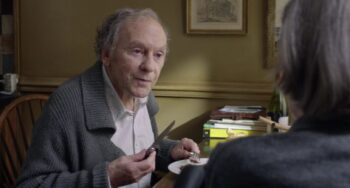
Georges and Anne are eating lunch at their kitchen table. Georges is telling Anne about a film he saw as a child. “Some banal love story,” he recalls, “about a nobleman and a lower middle class girl who can’t marry.” A few weeks earlier at this same table, Anne started staring into space. As it turned out, she was having a stroke. Now, although she’s alert and communicative, half of her body has been paralyzed. She requires Georges’s help with everything from picking up a book to going to the toilet.
The details of the film have faded from Georges’s memory, but he remembers vividly his youthful reaction to it: he was so emotional that it took him a long time to calm down. When he returned home from the cinema, he ran into an older boy who lived next door. This was a boy that Georges looked up to and had always been trying to impress, yet he couldn’t stop himself from crying as he described to him the film he’d just seen. “Telling him the story made all my feelings and tears come back,” Georges tells Anne, “maybe even stronger than when I was actually watching the film.”
In another film, this scene might be a testament to the power of cinema; in Amour, inserted between scenes of Georges struggling to move Anne’s broken body, it feels like a comment on how laughably trivial movies can be. It also sheds light on writer/director Michael Haneke’s most defining quirk: an intense aversion to banality. When one considers that Haneke’s output is among the most dour and least cathartic in all cinema, one can’t help but think that the idea of someone having a benignly positive reaction to Amour is the director’s worst nightmare.
Haneke is a polarizing figure. While it’s hard to deny his brilliance as a director, his films’ preoccupation with the fact that they are films and not real life – and what a very, very terrible thing that is – can feel condescending at times. There tends to be a certain amount of frustration that comes up when talking about Haneke. Even critics who praise his work tend to do so as one praises an unusually well-designed mausoleum.
You don’t need to hear this director compare Pulp Fiction to Nazi war propaganda to know that he fundamentally distrusts the medium in which he works. This distrust is evident in every facet of his work: the stubbornly stationary camera angles, the near absence of music, the way in which we are denied the violent images we expect, only to be ambushed by a sudden, brutal act of violence when we least expect it. The aim of all of this, according to the director himself, is to force us to question what we are being shown.
When I heard that Haneke’s new film would be called Amour, I actually thought the title might be sarcastic. After all, this is the guy who made the most disturbing home invasion film of all time and called it Funny Games. Thankfully, this film really is a love story. Yet it’s such a ruthlessly unsentimental one that the title still feels like a provocation.
 This is a film about love where the word love is seldom uttered – perhaps never mentioned by the two main characters – and where all the cinematic shorthand for love has been removed. What we are left with are the quiet presences of two people, their physical bodies, their conversations, the everyday moments they spend with each other. Moments eating, moments meeting friends, moments worrying, and increasingly, moments of Georges caring for Anne. The latter scenes are long, slow, and mostly wordless, and I suspect that it is this film’s willingness to show in detail just how punishing old age can be that is winning it praise even from those normally turned off by Haneke’s grim agenda.
This is a film about love where the word love is seldom uttered – perhaps never mentioned by the two main characters – and where all the cinematic shorthand for love has been removed. What we are left with are the quiet presences of two people, their physical bodies, their conversations, the everyday moments they spend with each other. Moments eating, moments meeting friends, moments worrying, and increasingly, moments of Georges caring for Anne. The latter scenes are long, slow, and mostly wordless, and I suspect that it is this film’s willingness to show in detail just how punishing old age can be that is winning it praise even from those normally turned off by Haneke’s grim agenda.
In most films about love it is a choice, a monologue, a letter, or a shedding of tears that “proves” to the audience that two people are really in love. The most beautiful thing about this film, to me, is how much love comes through in the (crazily good) performances of Jean-Louis Trintignant and Emmanuelle Riva, even as the director takes great pains to avoid providing us with any conventional cinematic signifiers of love.
Yet even though we can feel love suffusing this couple’s apartment, it’s a love that’s as slippery as a ghost, and much scarier. In 2000’s Code Unknown, which is still Haneke’s most gentle film, the failure of words to communicate feelings was symbolized by a classroom of deaf students playing a game of charades. As a girl crouches by a wall, seemingly shielding herself from something, the other kids make guesses with sign language – “Alone?”, “Hiding Place?”, “Sad?” – to which the girl shakes her head; a poetic reminder that all language is a physical process that can approach but never reach the heart.
This is echoed in Amour in perhaps its most memorable scene, a scene that begins with Georges telling Anne another story from his childhood: a holiday camp that he had hoped would be fun but turned out to be torture. His mother and he had made a deal that if he was enjoying the camp he would draw flowers on his postcard to her, and if he was suffering he would draw stars. Georges drew stars all over his postcard. That’s the best that language has to offer, Haneke seems to be saying.
Yet the shock for longtime viewers of Haneke is how Amour goes one step further. Rather than merely pointing out the inefficacy of language, here we have a powerful emphasis on our moral imperative to listen to words and to act on them – to take communication seriously, despite its failures. At a certain point in the film, Anne has deteriorated to the point where all she says is “mal”, the French word for pain, bad, hurt. In a fascinating moment, one of Anne’s nurses tells Georges that the repetition of the word is just a physical reflex with no meaning – Anne might as well be saying “maman, maman, maman”. But what argument could ever convince someone to ignore their lover repeating the word “pain” day and night? The film shows us Georges tormented by Anne’s words, and his inability to dismiss them might be the greatest testament to his love for her. Words may never be able to adequately describe feelings, but they can point the way, and love requires that we respect them and follow them.
On the surface, Haneke’s modus operandi hasn’t changed at all. The camera still barely moves, the characters still barely smile, the editing is still so phenomenally frugal that every cut feels like it’s accompanied by the Law & Order “shunk-shunk” sound. But two things have changed. One is that the director’s finger-wagging takes a backseat to the moral imperatives of the characters. The second is the inclusion of two highly sympathetic lead characters. Haneke’s films have always been a showcase for mind-blowing acting, but usually it’s of the sadistic, cold, deranged variety. The Georges and Anne in this film might be the first Georges and Anne (the names recur in almost all of Haneke’s films) that I wouldn’t be bummed to know in real life.
Now that Amour has received Oscar nominations not only for Best Foreign Film but for Best Picture, it is probably destined to be the best known and most watched of Haneke’s films in the States. Why is it receiving so many more accolades than his previous work? It might be more philosophically well-rounded, but it’s not any easier to watch. Maybe it’s simply that in portraying the slow deterioration of a spouse, Haneke has finally chosen a subject that frightens us as much as it frightens him. Unlike television, childhood, fascism, war, and cinema itself, aging is something that we are ready to believe is truly horrific.




